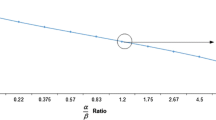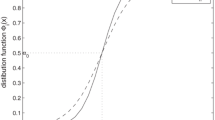Abstract
This paper demonstrates that an important role of intermediaries in supply chains is to reduce the financial risk faced by retailers. It is well known that risk averse retailers when faced by the classical single-period inventory (newsvendor) problem will order less than the expected value maximizing (newsboy) quantity. We show that in such situations a risk neutral distributor can offer a menu of mutually beneficial contracts to the retailers. We show that a menu can be designed to simultaneously: (i) induce every risk averse retailer to select a unique contract from it; (ii) maximize the distributor's expected profit; and (iii) raise the order quantity of the retailers to the expected value maximizing quantity. Thus inefficiency created due to risk aversion on part of the retailers can be avoided. We also investigate the influence of product/market characteristics on the offered menu of contracts.
Similar content being viewed by others
References
Andel, T. (1996) Manage inventory, own information. Transportation and Distribution, 37(5), 54-56.
Arrow, K.J. (1974) Essays in the Theory of Risk Bearing, North-Holland, New York, NY.
Baron, D.P. (1973) Point estimation and risk preferences. Journal of the American Statistical Association, 68, 944-950.
Bickel, P. and Lehmann, E. (1979) Descriptive statistics for non-parametric models. IV: spread, in Contributions to Statistics, Juneckova, J. (ed), Reidel Publishing Co, Boston, MA.
Bird, L. and Bounds, W. (1997) Stores' demands squeeze apparel companies. Wall Street Journal, Eastern edition, Jul 15, B1:3.
Carvajal, D. (1998) Publishing industry's focus shifts to limiting returns. New York Times, Late edition (East Coast), Jul 27, D9:1.
Eeckhoudt, L., Gollier, C. and Schlesinger, H. (1995) The risk averse (and prudent) newsboy. Management Science, 41(5), 786-794.
Eppen, G.D. and Schrage, L.E. (1981) Effects of centralization in a multi-warehouse system with lead times and random demand, Chapter 3 in Multi-Level Inventory/Production Control Systems: Theory and Practice, Schwarz, L.B. (ed), North-Holland, Amsterdam.
Federgruen, A. and Zipkin, P. (1984) Approximations of dynamic multilocation production and inventory problems. Management Science, 30, 69-84.
Horowitz, I. (1970) Decision Making and the Theory of the Firm, Holt, Rinehart, and Winston, New York, NY.
Jackson, P.L. and Muckstadt, J.A. (1989) Risk pooling in a two-period, two-echelon inventory stocking and allocation problem. Naval Research Logistics Quarterly, 36, 1-26.
Kirkpatrick, D. (1997) Now everyone in PCs wants to be like Mike. Fortune, 136(5), 91-92
Kreps, D.M. (1990) A Course in Microeconomic Theory, Princeton University Press, NJ, p. 588.
Landsberger, M. and Meilijson, I. (1994) The generating process and an extension of Jewitt's location independent risk concept. Management Science, 40, 662-669.
Lucas, A. (1996) Shelf Wars. Sales and Marketing Management, 148, 3.
Moses, M. and Seshadri, S. (2000) Policy parameters for supply chain coordination. IIE Transactions on Operations Engineering, 32(3), 245-262.
Oren, S.S., Smith, S.A. and Wilson, R.B. (1983) Competitive nonlinear tariffs. Journal of Economic Theory, 29, 49-71.
Pratt, J.W. (1964) Risk aversion in the small and in the large. Econometrica, 32, 122-136.
Rothschild, M. and Stiglitz, J.E. (1970) Increasing risk: I. a definition. Journal of Economic Theory, 2, 225-243.
Rothschild, M. and Stiglitz, J.E. (1971) Increasing risk: II. its economic consequences. Journal of Economic Theory, 3, 66-84.
Rothschild, M. and Stiglitz, J.E. (1972) Addendum to increasing risk: I. a definition. Journal of Economic Theory, 5, 306.
Rothschild, M. and Stiglitz, J.E. (1976) Equilibrium in competitive insurance markets: an essay on the economics of imperfect information. Quarterly Journal of Economics, 80, 629-649.
Schwarz, L.B. (1989) A model for assessing the value of warehouse risk-pooling: risk-pooling over outside supplier lead-times. Management Science, 35, 828-842.
Schwarz, L.B., Deuermeyer, B.L. and Badinelli, R.D. (1985) Fill-rate optimization in a one-warehouse N-identical retailer distribution system. Management Science, 31, 488-498.
Shaked, M. and Shanthikumar, J.G. (1994) Stochastic Orders and Their Applications, Academic Press, San Diego, CA.
Stiglitz, J.E. (1977) Monopoly, non-linear pricing and imperfect in-formation: the insurance market. Review of Economic Studies, 44, 407-430.
Tsay, A.A., Nahmias, S. and Agrawal. (1999) Modeling supply chain contracts: a review, Chapter 10 in Tayyur, S., Ganesan, R. and Magazine, M. (eds) Quantitive Models for Supply Chain Management. Kluwer Academic Publishers, Boston, MA., pp. 299-336.
Weng, Z.K. (1995) Channel coordination and quantity discounts. Management Science, 41(9), 1509-1522.
Wilson, R. (1993) Non-Linear Pricing, Oxford University Press, New York, NY.
Author information
Authors and Affiliations
Rights and permissions
About this article
Cite this article
Agrawal, V., Seshadri, S. Risk intermediation in supply chains. IIE Transactions 32, 819–831 (2000). https://doi.org/10.1023/A:1007630925625
Issue Date:
DOI: https://doi.org/10.1023/A:1007630925625




